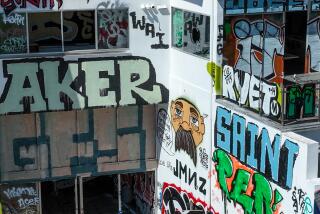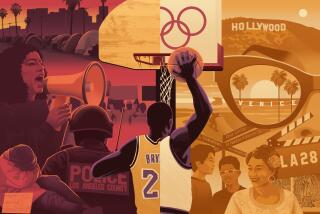Picture This on Downtown’s Doorstep
- Share via
All cities contain ill-conceived developments, some the result of simple greed, others of misguided good intentions. But a single building project, no matter how bad, usually can be absorbed into the ever-changing urban fabric.
The Angel City development, with its City of Angels Monument, proposed for a prominent site in downtown Los Angeles, could be the rare exception. It is a project so ill-conceived, so vast in scale and so perfectly located that its potential ill effects could extend far beyond its immediate context.
The $3.6-billion development is the brainchild of Brett-Livingstone Strong, an artist best known for his sculptures of Hollywood celebrities. The proposed project would occupy a critical 88-acre site along the 110 Freeway, west of downtown and north of the Santa Monica Freeway, and would include all of the standard development cliches: three theme hotels, a vast entertainment complex and a retail mall.
Strong says he has already obtained $200 million in loans to secure the site, and that he will close escrow on 55 of the 88 acres by the end of the year. He also claims to have tentative commitments from Lehman Brothers and Swiss Re Insurance to help fund construction of the tower. And he has hired Gensler Architects--a reputable local design firm--to work out the details of his design.
Strong’s ambitious vision goes well beyond the typical urban development scheme. He wants to create a new symbol for Los Angeles--the city’s equivalent of the Eiffel Tower or Statue of Liberty. Dominated by a 750-foot-tall tower with an enormous sculpture of a winged angel perched on top, his mega-complex would dominate the surrounding cityscape, a grotesque parody of this city’s reputation as the world entertainment capital. If Angel City is built, it will do more than damage Los Angeles’ long-standing efforts to transform downtown into a credible cultural hub. It will become a permanent blot on the city’s civic and cultural identity.
There is no shortage of irony here. Strong began his career carving tombstones in Australia, and the design for Angel City has a surprisingly morbid look for an entertainment complex geared toward family fun. The skeletal steel frames of a dozen pseudo-Gothic buttresses creep up the City of Angels Monument’s base on all sides. At its top, the monument’s cylindrical form splays open to provide a base for the angel, whose clinging drapery and muscular form evoke a blend of rock ‘n’ roll erotica and funereal kitsch. Picture a giant tombstone for the city.
But the monument is only the most visible feature in a vast landscape of grotesquely overwrought structures. The exterior of a hotel tower, for instance, curves out to enclose an artificial indoor ski slope, its facade covered with decorative fins. A dense retail block--with a heavy steel drum punched through its facade--evokes the grim industrial plants of a mythical Gotham City. Nearby, a greenhouse-like building would contain a faux Victorian house--a perverse nod to the site’s once-rich architectural history. These and dozens of other equally monstrous structures would be scattered over a 40-acre park, along with faux Roman aqueducts, ornate fountains and massive, buttressed steel gates that Strong claims are inspired by Gothic cathedral architecture.
In fact, Strong’s structures seem closer in spirit to Hollywood’s darkest sci-fi spectacles. The best of these celluloid cities, such as Anton Furst’s sets for the 1989 movie “Batman,” are haunting visions of urban metropolises run amok, dense cityscapes shaped by unrestrained corporate greed. But Strong’s plan turns this concept on its head, ignoring the surrounding city to create a theme-park environment, with its inevitable security guards and corporate controls. The model here is Disneyland, not a real cityscape. A monorail would circle endlessly above the buildings. Fortified gates would protect the site from unwanted intruders. The existing low-rise bungalows that flank the development’s western edge would be treated like a dangerous alien colony.
*
Such an anti-urban strategy is in keeping with Angel City’s main mission, which is to attract tourist dollars. As if to underscore that point, Strong is proposing a high-speed Metro line that would link the complex directly to Los Angeles International Airport. The tower itself is nothing more than a device to promote consumption. In a sort of vertical reworking of Universal CityWalk, it would house a rock ‘n’ roll museum, restaurants, a viewing deck and a nondenominational cathedral.
A proposal like Strong’s wouldn’t matter much in a sane world, where such urban grotesqueries would be snickered at and then dismissed out of hand by city officials, urban planners and horrified citizens. But Strong already can cite support from many of the city’s civic and cultural leaders. Mayor Richard Riordan, for instance, has praised the plan as “a magnificent and inspiring project.” Former Museum of Contemporary Art director Richard Koshalek called it “[an] impressive undertaking.”
Part of the reason for such unfounded praise, no doubt, stems from city leaders’ desperate desire to draw large-scale new development to downtown. But I suspect the scheme also taps into a much deeper, unspoken insecurity about the city’s identity: the sense that Los Angeles is somehow a second-rate city because its only identifiable civic symbol is a creaky sign on a scruffy hill high above Hollywood.
*
There have been other efforts to create a new emblem for Los Angeles, not all of them bad. During the boom years of the ‘80s, the city sponsored an international competition for the design of a new gateway to the west in the spirit of New York’s Statue of Liberty. The winning design, by the team of Hani Rashid and Lisanne Couture, would have created a dazzling urban vision: a massive scaffolding-like frame rising up from the median strip of the 101 Freeway, its wiry form packed with a wild assortment of cultural venues--including an outdoor cineplex and an aquarium. What made the project so convincing, however, was the team’s deep understanding of Los Angeles’ hidden urban patterns. They recognized a community of fractured enclaves, divided by class, race and distance, bound together by the freeway.
Strong’s plan displays no such sensitivity to this city’s unique urban structure. Its vision is a pastiche of outdated and unrelated images of a futuristic Metropolis--a set designer’s fantasy without regard for its cultural or physical context. The project is a crass commercial development with no artistic merit, shaped by cynical intentions.
To build it would drive a stake through the city’s heart. *
More to Read
The biggest entertainment stories
Get our big stories about Hollywood, film, television, music, arts, culture and more right in your inbox as soon as they publish.
You may occasionally receive promotional content from the Los Angeles Times.










